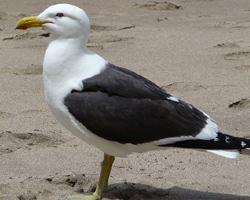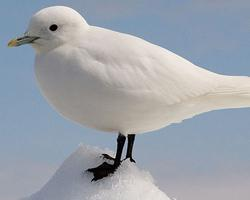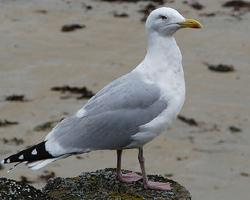
Starea de conservare
| Amenințat |
Descrierea animalului
The Kelp Gull (Larus dominicanus), also known as the Dominican Gull, is a large species of gull that inhabits a wide range of coastal environments across the Southern Hemisphere. This bird species is highly adaptable, showcasing a remarkable versatility in both its diet and habitat preferences, which has allowed it to thrive in areas ranging from the icy shores of Antarctica to the warmer coastal beaches of South Africa, Australia, and South America.Characteristically, the Kelp Gull exhibits a striking plumage that serves as an easy identifier among seabirds. Adults are marked by their white heads, bodies, and tails, contrasting sharply with their black backs and upper wing surfaces. The wings are tipped with white, and this distinct pattern is often visible in flight, making them a spectacular sight against the coastal landscapes they frequent. Their legs are a strong yellow, matching the color of their large bills, which feature a notable red spot on the lower mandible—a common trait among gulls that aids in feeding behavior.
Juvenile Kelp Gulls pass through various plumage stages, gradually transitioning from a mottled brown appearance to the sleek, contrasting colors of adulthood over a few years. This gradual maturation process is a fascinating aspect of their life cycle, reflecting the adaptability and survival skills required to navigate the complex ecosystems they inhabit.
Kelp Gulls are omnivorous, demonstrating an impressive dietary flexibility that includes fish, mollusks, insects, and even small mammals or birds. They are also known to scavenge, taking advantage of carrion and human refuse, which has allowed them to thrive in areas of human activity. This opportunistic feeding behavior showcases their intelligence and adaptability but also highlights the potential for conflict in areas where human and wildlife interests intersect.
Breeding behaviors of the Kelp Gull are as diverse as their diet. They are colonial nesters, typically forming large breeding colonies on islands, cliffs, and sometimes even urban rooftops. Their nests are constructed from seaweed, grass, and other plant materials, forming a sturdy platform for their eggs. Both parents are involved in the incubation process, demonstrating a strong pair bond and shared responsibility for raising their young. The chicks are semi-precocial, hatching with their eyes open and covered in down, ready to face the challenges of their environment with parental guidance.
Conservation status of the Kelp Gull is currently listed as Least Concern by the International Union for Conservation of Nature (IUCN), reflecting their wide distribution and stable population numbers. However, like many seabird species, they face threats from pollution, habitat loss, and climate change. The resilience of the Kelp Gull is a testament to its adaptability, but it also underscores the importance of continued conservation efforts to ensure that these remarkable birds remain a familiar sight along our coastlines.
In summary, the Kelp Gull is a fascinating example of avian adaptation and survival. Its broad geographical range and dietary habits highlight the species' versatility, while its complex social behaviors and breeding strategies offer insight into the intricate dynamics of coastal ecosystems. As an emblem of the rugged, unyielding nature of the sea, the Kelp Gull stands as a reminder of the beauty and resilience of our planet's wildlife.
Animale similare
Fotografii noi cu animale
Top 10 animale
- Dolphin gull (Leucophaeus scoresbii)
- Diana monkey (Cercopithecus diana)
- Moustached guenon (Cercopithecus cephus)
- Stone loach (Barbatula barbatula)
- Greek tortoise (Testudo graeca)
- Galápagos tortoise (Geochelone nigra complex)
- Japanese macaque (Macaca fuscata)
- Russian tortoise (Testudo horsfieldii)
- Common flying dragon (Draco volans)
- Galápagos penguin (Spheniscus mendiculus)


